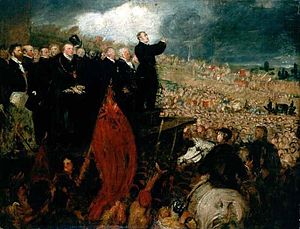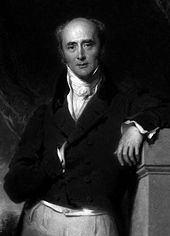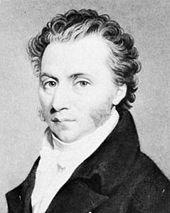- Days of May
-
The Days of May was a period of social unrest and political tension in the United Kingdom that took place in May 1832, following the wrecking by Tories in the House of Lords of the Third Reform Bill, which aimed to extend parliamentary representation to the middle class and to the newly industrialised cities of the English Midlands and the North of England.
The campaign to broaden the electoral franchise had garnered a wide and organised national support over the preceding years, led by Thomas Attwood's Birmingham Political Union, which boasted that it "had united two millions of men peaceably and legally in one grand and determined association to recover the liberty, the happiness, and the prosperity of the country".[1] While Attwood was careful to keep the unions' activities legal and non-violent, he also encouraged the widespread belief that they had the potential to constitute a powerful and independent extra-parliamentary force, boasting that the nation could be mobilised in an hour.[2] The fall of the bill, and the subsequent resignation of the Whig government of Lord Grey, were met with rioting, campaigns of economic sabotage and threats of armed insurrection that were judged by many contemporaries to be credible.
The crisis was defused with the reinstatement of Grey's government on 15 May and King William IV's agreement in principle to create enough new peers to build a Whig majority in the Lords and allow the bill to pass. The Lords backed down short of this measure and the Great Reform Act was finally passed by Parliament and received Royal Assent on 7 June 1832.
Although the extent to which extra-parliamentary pressure was decisive in securing the passage of the bill is a matter for debate among historians, the period has come to be seen as one of the times when the UK came closest to revolution.
Contents
Background
Parliamentary representation was limited and haphazard in eighteenth and early nineteenth century Britain: in 1780 it was calculated that there were only 214,000 qualified to vote in England and Wales out of a total population of 8 million, and property qualifications varied widely between consituencies.[3] The onset of the industrial revolution wrought sweeping social and economic change across the country, but the unchanging electoral system that continued left political structures increasingly unable to reflect the realities of economic power in the country. In 1830 fifty-six rotten boroughs elected two MPs each but had electorates of fewer than fifty,[4] while Manchester, Birmingham, Leeds and Sheffield, with a combined population of more than 540,000, had not one MP between them.[5]
Reform also had a record of inspiring popular discontent. In 1819 a crowd of 15,000 had gathered at Newhall Hill in Birmingham to symbolically elect Charles Wolsley as the town's "Legislatorial Attorney and Representative" in Westminster; when Manchester followed Birmingham's lead 2 months later troops opened fire and killed 15 in the event that became known as the Peterloo Massacre.[6]
Sporadic unsuccessful attempts to abolish specific rotten boroughs and transfer representation to larger towns were carried out by Lord John Russell throughout the 1820s,[7] but the election of a Whig government headed by Lord Grey in November 1830 was the first occasion when a ministry committed to parliamentary reform took office.[8] Grey formed a committee to draft reform proposals that would be sufficient to quell public opinion and "afford sure ground of resistance to further innovation",[9] but the resulting Reform Bill received only lukewarm support in parliament and further elections were held in May 1831.[10] Newly armed with a majority of over 130 seats Grey introduced a Second Reform Bill in July 1831, which passed through the House of Commons with a majority of 140, but was defeated in the House of Lords in October amid rioting in Derby, Nottingham and Bristol.[11]
By the 1830s the most influential extra-parliamentary support for reform came from the Birmingham Political Union, which had been founded by Thomas Attwood in December 1829 as "a General Political Union between the lower and middle classes of the people" to engineer the political reform that Attwood had come to think necessary to achieve his ultimate goal of currency reform.[12] The unusually small size of the units of production characteristic of the Birmingham economy, coupled with the resulting high degree of social mobility and shared economic interest between Birmingham workers and factory owners, enabled the BPU to attract a broad support across classes[13] and maintain its position of leadership among the hundreds of more fragmented unions that followed its example and formed across the country in 1830 and 1831.[14]
The BPU had made its reputation amid the spontaneous rioting that had accompanied the fall of the First Reform Bill in 1831, assembling 150,000 protesters at Newhall Hill in the largest political assembly the country had ever seen.[15] Its threat to reorganise itself along semi-military lines in November 1831 had led to suggestions that it was trying to usurp the civil authority, and made a deliberate, if implicit, threat of the possibility of armed revolt in the event of the formation of an anti-reform government.[16] The Times called the BPU "the barometer of the reform feeling throughout England",[17] while Attwood himself was dubbed "King Tom" by William Cobbett and described by Francis Place as "the most influential man in England".[18]
Causes of the riots
Change of leader
On 9 May 1832, after the Great Reform Act had been vetoed by the House of Lords, the then Prime Minister, Earl Grey, handed in his resignation. He was replaced by the Duke of Wellington, a Tory, who opposed the Reform Act. Lord Grey commented that Wellington was a man who "didn't understand the character of the times", referring to the fact that Wellington believed the pressure for change was insignificant and the electoral was fine as it was.
BPU meeting
The news of Grey's resignation was not reported in London on the day it happened, but on 10 May 1832, news reached Birmingham about the situation.
Progress and events
Pro-reform organisations such as the Birmingham Political Union played a major part in the protests; their membership swelled, causing politicians to fear an armed riot. In other parts of the country, armed mobs attacked the homes of prominent members of the peerage who had opposed reform. Petitions were also presented from around the country. On 15 May, Wellington resigned and Grey was invited to return to form a government. The House of Lords subsequently agreed to the Bill after William IV threatened to create dozens of Whig peers to overwhelm the opposition.
Revolutionary potential
Although at the time it was claimed that the nation could be mobilised in an hour commentators disagree on how real the threat of revolution was during the Days of May. Contemporary observers had little doubt: Edward Littleton, then a Whig MP, commented in his diary that the country was "in a state little short of insurrection",[19] while the Anglican clergyman Sydney Smith later described a "hand-shaking, bowel-disturbing passion of fear".[20] As Thomas Creevey observed, this fear was shared by the Queen, whose "fixed impression, is that an English revolution is rapidly approaching, and that her own fate is to be that of Marie Antoinette"[21] Some more modern historians agree: E. P. Thompson wrote that "in the autumn of 1831 and in the 'Days of May' Britain was within an ace of revolution" and Eric Hobsbawm felt that "This period is probably the only one in modern history ... where something not unlike a revolutionary situation might have developed."[22]
References
- ^ Flick 1971, p. 356
- ^ Ferguson 1996, p. 269
- ^ Evans 1983, p. 5
- ^ Evans 1983, p. 5
- ^ Evans 1983, p. 4
- ^ Moss 1990, pp. 77–78
- ^ Cannon 1973, pp. 177–188
- ^ Cannon 1973, p. 203
- ^ Cannon 1973, p. 204
- ^ Evans 1983, p. 32
- ^ Evans 1983, p. 33
- ^ LoPatin-Lummis 2008
- ^ Briggs 1952, pp. 297–298
- ^ Rudé 1967, p. 95
- ^ Flick 1971, p. 359. "It was the great meetings called by the council to support the new Whig government's reform bill which gave the union its reputation. There is little doubt but that they were the largest political assemblages held in England to that date."
- ^ Ferguson 1960, pp. 268–269
- ^ Briggs 1952, p. 300
- ^ Briggs 1948, p. 190
- ^ Hilton 2006, p. 426
- ^ Hilton 2006, p. 426
- ^ Butler 1914, p. 379
- ^ Martin 1996, p. 89
Bibliography
- Briggs, Asa (1948), "Thomas Attwood and the Economic Background of the Birmingham Political Union", Cambridge Historical Journal 9 (2): 190–216, JSTOR 3020620
- Briggs, Asa (1952), "The Background of the Parliamentary Reform Movement in Three English Cities (1830-2)", Cambridge Historical Journal 10 (3): 293–317, JSTOR 3021116
- Butler, J. R. M. (1914), The Passing of the Great Reform Bill, Longmans Green, OCLC 891220, http://www.questia.com/read/72380623, retrieved 2009-11-11
- Cannon, John Ashton (1973), Parliamentary Reform 1640-1832, Cambridge University Press, ISBN 0521097363, http://books.google.co.uk/books?id=C0M4AAAAIAAJ, retrieved 2009-11-10
- Evans, Eric J. (1983), The Great Reform Act of 1832, Routledge, ISBN 041634450X, http://books.google.co.uk/books?id=D509AAAAIAAJ, retrieved 2009-11-07
- Ferguson, Henry (March 1960), "The Birmingham Political Union and the Government 1831-32", Victorian Studies 3 (3): 261–276, JSTOR 3825499
- Flick, Carlos T. (August 1971), "Thomas Attwood, Francis Place, and the Agitation for British Parliamentary Reform", The Huntington Library Quarterly 34 (4): 355–366, JSTOR 3816950
- Hilton, Boyd (2006), A Mad, Bad, and Dangerous People?: England, 1783-1846, Oxford University Press, ISBN 0198228309, http://books.google.co.uk/books?id=D37VByMZSaUC, retrieved 2009-11-07
- LoPatin-Lummis, Nancy (2008), "Birmingham Political Union (act. 1829–1839)", Oxford Dictionary of National Biography (Online ed.), Oxford University Press, http://www.oxforddnb.com/view/theme/42285, retrieved 2009-11-06
- Martin, Howard (1996), Britain in the Nineteenth Century, Cheltenham: Nelson Thornes, ISBN 0174350627, http://books.google.co.uk/books?id=SjPDDaMhns0C, retrieved 2009-11-06
- Moss, David J. (1990), Thomas Attwood: The Biography of a Radical, Montreal: McGill-Queen's Press, ISBN 0773507086, http://books.google.co.uk/books?id=erYD3ZwVLnkC, retrieved 2009-11-06
- Royle, Edward (2000), Revolutionary Britannia?: Reflections on the Threat of Revolution in Britain, 1789-1848, Manchester: Manchester University Press, ISBN 0719048036, http://books.google.co.uk/books?id=QOH6RjquDzcC, retrieved 2009-11-06
- Randall, Adrian (2006), Riotous Assemblies: Popular Protest in Hanoverian England, Oxford University Press, ISBN 0199259909, http://books.google.co.uk/books?id=aprEJzPT0RMC, retrieved 2009-11-10
- Rudé, George (July 1967), "English Rural and Urban Disturbances on the Eve of the First Reform Bill, 1830-1831", Past and Present (37): 87–102, JSTOR 650024
External links
Categories:- 1832 riots
- Riots and civil disorder in England
- 1832 in the United Kingdom
Wikimedia Foundation. 2010.




